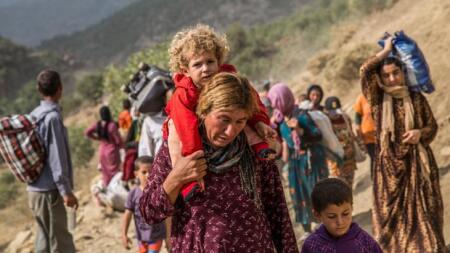
4 July 2017
Yezidi communities; the most affected people who suffered all types of crimes by ISIS. On the 3rd of August 2014, ISIS took control of Ninawa and other cities in Iraq. This was followed by a well-coordinated and planned offensive on Sinjar district in the most brutal attack carried out by the ISIS terrorist group to date. ISIS systematically targeted the Yezidi population for their distinct religious identity.
Among the most heinous atrocities committed by the group were mass execution of civilians, abduction and enslavement of women and girls and in-discriminate killing of the Yezidi men. As a result, the Yezidi population has suffered the gravest atrocities committed by the group, have lost all their sources of subsistence and been displaced across the Kurdistan Region. The destruction measured in human and material loss is of such a magnitude that millions of dollars will be needed for recovery, healing, reconstruction and development over many years to come.
Yezidi population were 550,000 people before the ISIS attack across Iraq, as a result, 360,000 individuals were displaced, in which nearly 90,000 of them left abroad due to the ISIS war.
ISIS enslaved 6417 Yezidis, of which 3547 of them are women, and 2870 are men. Out of that number 3048 Yezidis (1092 women, 334 men and 1622 children) have been rescued and escaped from ISIS.
The ISIS attacks resulted in 2745 children became orphans, 1759 children without father, 407 without mother, 359 from the parents and 220 children still have their parents held by ISIS. While there are still 3369 Yezidis (1636 women and 1733 men) remaining under ISIS enslavement.
Additionally, there are 43 mass graves as well as dozens of individual graves found in the Yezidi populated areas in Sinjar district. And also 68 Yezidi shrines and holy places were destroyed by ISIS terrorists.

Sinjar (Shingal in Kurdish) district is composed of three sub-districts; Sinone (Al-shimal), Qayrawan (lbleech) and GirOzer (Al-qahtaniya). Sinjar is located northwest of Ninawa province, bordering Syria and 380 km from Erbil and 126 km from Mosul. With a surface of 3,188km2, Sinjar had a mixed population of estimated 400,000 before the invasion of ISIS in August 2014. Estimated ninety three thousand (93,000) families were living in the city of Sinjar and the remaining scattered across the surrounding villages. The district is mainly composed of small rural communities living on agricultural produce (wheat and barley, livestock etc.).
The area is considered the ancient land of the Yezidi people, a Kurdish minority adhering to the Yezidi religion. Prior to the displacement, the district was inhabited by a majority Yezidi population but also other ethnic and religious minorities including Arab Shiite and Sunnis, Christians and Kurdish Muslims. For decades, Sinjar had been marginalized as former Iraqi governments had remained reluctant to invest in socio-economic development and service delivery in the district. Thus, the district has experienced decades of social, economic, political and cultural marginalization as well as repeated acts of violence and genocide committed against its population, especially the Yezidis.
Hence, historical and geopolitical factors and isolation have contributed to the emergence of rather closed communities that have been deprived from basic developments and opportunities. Marginalization has resulted in under-achievement in education, public health and other social indicators as well as negligible economic development resulting in limited employment and other livelihood opportunities. Despite a history of deprivation and marginalization by the former Iraqi regimes, Yezidis have endured the hardship while remaining in their lands and successfully preserving their unique religious faith and practices.

